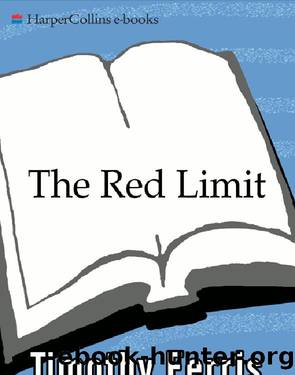The Red Limit by Timothy Ferris

Author:Timothy Ferris
Language: eng
Format: epub
Publisher: HarperCollins
Gamow, Alpher and Herman, the men most vindicated by the discovery of the cosmic background radiation, greeted the news with mixed emotions. They were astonished to find that the discoverers’ papers did not credit their foresight. Dicke mentioned their attempt to account for synthesis of the elements in the Big Bang, an effort which had failed, but was silent on the prediction of the background radiation, which now had triumphed. Peebles too was silent. So were Penzias and Wilson. Gamow wrote an indignant letter in his round scrawl to Penzias, listing the occasions when Alpher and Herman had prophesied the background radiation. Gamow had even mentioned it (though at an inflated estimate of 50 degrees, his arithmetic having proven undependable as ever) in his book The Creation of the Universe, a best seller that had sold nearly a quarter of a million copies. “You see,” Gamow wrote, “the world did not start with almighty Dicke.”
Then in his sixties, Gamow occupied a cottage in Boulder, Colorado, wrote popular books on science, answered his voluminous mail with notes, line drawings or poems, drank too much and told friends that each day he felt more strongly that nature was profoundly simple. The dust in space between the stars, he wrote, “has about the same constitution as the dust clouds raised by a bulldozer working on a mountain road.” At an astrophysics conference he chaired a session on the microwave background radiation and joked about the way the prediction that his colleagues Alpher and Herman had made had been overlooked: “If I lose a nickel, and someone finds a nickel, I can’t prove it’s my nickel. Still, I lost a nickel just where they found one.” In the last weeks of his life he had recurrent dreams of talking with Newton and Einstein. He died on August 20, 1968.
His younger collaborators, Alpher and Herman, had dropped out of cosmology. Herman went to General Motors, where he applied his skills to examining automobile traffic. He first developed a theory to predict the behavior of cars on single-lane highways, then moved to multilane traffic, then to crossings and complicated patterns like the entrance to the George Washington Bridge. Later, at the University of Texas, he studied the application of physics to the problems that afflict societies. “The future of the world, if it rests on any single issue,” he said over lunch in Austin in 1982, “may rest on the ability of science to handle complex problems.”
Alpher took a job at General Electric’s laboratory in Schenectady, New York. In 1971 he gave up science and moved to an administrative position at GE. “I left science in part because I was kind of disillusioned by the poor scholarship of so many scientists,” he said. “Not only Dicke but others. It was discouraging. I would still like to get back into physics at some time in the future, though, if I can still do physics.”
Download
This site does not store any files on its server. We only index and link to content provided by other sites. Please contact the content providers to delete copyright contents if any and email us, we'll remove relevant links or contents immediately.
| Aeronautics & Astronautics | Astronomy |
| Astrophysics & Space Science | Comets, Meteors & Asteroids |
| Cosmology | Mars |
| Solar System | Star-Gazing |
| Telescopes | UFOs |
Tools of Titans by Timothy Ferriss(8215)
Turbulence by E. J. Noyes(7935)
Secrets of Antigravity Propulsion: Tesla, UFOs, and Classified Aerospace Technology by Ph.D. Paul A. Laviolette(5309)
Astrophysics for People in a Hurry by Neil DeGrasse Tyson(5130)
Room 212 by Kate Stewart(5035)
Design of Trajectory Optimization Approach for Space Maneuver Vehicle Skip Entry Problems by Runqi Chai & Al Savvaris & Antonios Tsourdos & Senchun Chai(5011)
Pale Blue Dot by Carl Sagan(4907)
The David Icke Guide to the Global Conspiracy (and how to end it) by David Icke(4624)
A Journey Through Divination and Astronomy by Publishing Pottermore(4341)
Goodbye Paradise(3724)
Apollo 8 by Jeffrey Kluger(3635)
COSMOS by Carl Sagan(3553)
Losing the Nobel Prize by Brian Keating(3498)
The Five People You Meet in Heaven by Mitch Albom(3474)
How to Read Water: Clues and Patterns from Puddles to the Sea (Natural Navigation) by Tristan Gooley(3406)
Brief Answers to the Big Questions by Stephen Hawking(3369)
How to Read Nature by Tristan Gooley(3249)
The Order of Time by Carlo Rovelli(3144)
A Brief History of Time by Stephen Hawking(2959)
